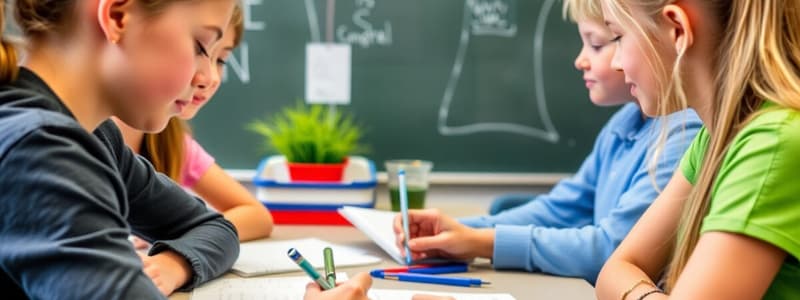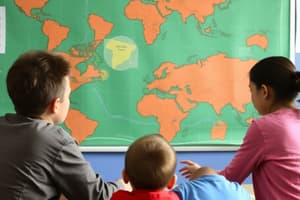Podcast
Questions and Answers
Which level of curriculum integration includes a common theme chosen by a group of teachers?
Which level of curriculum integration includes a common theme chosen by a group of teachers?
- Level 3: Curriculum Integration
- Level 1: Curriculum Integration
- Level 2: Curriculum Integration
- Level 5: Curriculum Integration (correct)
Integrative teaching and learning are synonymous with multidisciplinary teaching.
Integrative teaching and learning are synonymous with multidisciplinary teaching.
True (A)
What does Johnson and Johnson (1998) define integrative curriculum as?
What does Johnson and Johnson (1998) define integrative curriculum as?
A single course that contains one or more disciplines.
Theories supporting curriculum integration include Experiential Learning and ______.
Theories supporting curriculum integration include Experiential Learning and ______.
Match the following levels of curriculum integration with their descriptions:
Match the following levels of curriculum integration with their descriptions:
Ano ang Republic Act 10533?
Ano ang Republic Act 10533?
Ang estado ay dapat lumikha ng isang functional na sistema ng batayang edukasyon.
Ang estado ay dapat lumikha ng isang functional na sistema ng batayang edukasyon.
Ano ang layunin ng Republic Act 10533?
Ano ang layunin ng Republic Act 10533?
Ipares ang mga sanhi at kategorya sa ilalim ng Republic Act 10533:
Ipares ang mga sanhi at kategorya sa ilalim ng Republic Act 10533:
Ang ____ ay isang pamamaraan ng pagkatuto na nakabatay sa karanasan.
Ang ____ ay isang pamamaraan ng pagkatuto na nakabatay sa karanasan.
Ilang tema ang nakasaad sa programa?
Ilang tema ang nakasaad sa programa?
Flashcards are hidden until you start studying
Study Notes
Integrated Curriculum
- Curriculum Integration refers to both a teaching method and a planning strategy for organizing instruction.
- It involves linking new information to prior learning and connecting different parts of learning.
- There are five levels of curriculum integration, ranging from traditional to highly integrated approaches.
Levels of Curriculum Integration
- Level 1: Traditional Curriculum Integration - Involves a single teacher delivering a lesson in a traditional subject-based format.
- Level 2: Thematic Curriculum Integration - Single teacher incorporates themes, but they may not necessarily align with themes in other subjects.
- Level 3: Multidisciplinary Curriculum Integration - Two or more teachers collaborate on a common theme, covering multiple subjects.
- Level 4: Interdisciplinary Curriculum Integration - Teachers from different subjects collaborate on a common theme, blending subject boundaries.
- Level 5: Integrated Thematic Curriculum Integration - A group of teachers works together to create a highly integrated curriculum with a common theme, transcending all subject boundaries. This is the highest level of integration.
Theories Supporting Curriculum Integration
- Experiential Learning Theory (Carl Rogers): Learning occurs through constructive processes, addressing learner needs and wants.
- Multiple Intelligences Theory (Howard Gardner): Proposes nine categories of intelligence, emphasizing the diverse ways individuals learn.
Republic Act 10533 - The Enhanced Basic Education Act of 2013
- Aims to develop productive and responsible citizens with essential competencies, skills, and values for lifelong learning and employment
- Emphasizes the development of individuals who are:
- Mapanuri (Critical)
- Mapagmuni (Reflective)
- Mapanagutan (Responsible)
- Produktibo (Productive)
- Makakalikasan (Environmentally conscious)
- Makabansa (Patriotic)
- Makatao (Humane)
- Incorporates a national and global perspective, promoting an understanding of social issues throughout history, present, and future.
Design & Framework
- Features a spiral approach (cyclical) and decongestion of curriculum
- The Conceptual Framework is based on the following learning theories:
- Constructivism
- Collaborative Learning
- Experiential and Contextual Learning
Implementing Methods
- Investigation
- Thematic-Chronological & Topical/Conceptual
- Integration/Interdisciplinary or Multidisciplinary
Seven Major Themes Covered
- Tao, Lipunan at Kapaligiran (People, Society and Environment)
- Panahon, Pagpapatuloy, at Pagbabago (Time, Continuity and Change)
- Kultura, Pagkakakilanlan at Pagkabansa (Culture, Identity and Nationhood)
- Karapatan, Pananagutan at Pagkamamamayan (Rights, Responsibilities and Citizenship)
- Kapangyarihan, Awtoridad, at Pamamahala (Power, Authority, and Governance)
- Produksyon, Distribusyon at Pagkonsumo (Production, Distribution and Consumption)
- Ugnayang Panrehiyon at Pangmundo (Regional and Global Relations)
Thematic Grade-Level Breakdown
- G5 - Pagbuo ng Pilipinas bilang Nasyon (Formation of the Philippines as a Nation)
- G6 - Mga Hamon at Tugon Pagkabansa (Challenges and Responses to Nationhood)
- G7 - Araling Asyano (Asian Studies)
- G8 - Kasaysayan ng Daigdig (World History)
- G9 - Ekonomiks (Economics)
- G10 - Mga Kontemporaryong Isyu (Contemporary Issues)
- G11 - Personal Development
- G12 - Understanding Culture, Politics and Society
Skills Development
- Creativity
- Critical Thinking
- Sound Decision-Making
- Research and Inquiry
- Historical Skills
- Communication and Global Perspective
Four Pillars of Learning
- Makaalam (Learning to Know)
- Makagawa (Learning to Do)
- Maging Ganap (Learning to Be)
Assessment and Monitoring
- Uses program standards
- Focuses on the understanding of historical, geographical, economic, cultural, governmental, civic, and social concepts and issues
- Emphasizes the development of research, inquiry, critical thinking, sound decision-making, creativity, interpersonal skills, sustainable resource utilization, communication, and a broadened global perspective.
Studying That Suits You
Use AI to generate personalized quizzes and flashcards to suit your learning preferences.




